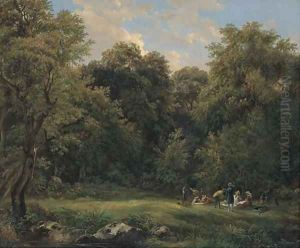Adrian Ludwig Richte Paintings
Adrian Ludwig Richter, often known simply as Ludwig Richter, was a significant German painter and etcher of the Romantic period. Born on September 28, 1803, in Dresden, Germany, he was the son of Carl August Richter, who was also a painter. Ludwig was exposed to art at a young age due to his father's influence and began his formal education at the Dresden Academy of Fine Arts. He was primarily influenced by the works of Caspar David Friedrich and was part of a movement that sought to depict nature as a manifestation of divine creation.
Richter's style was characterized by its attention to detail, use of light, and a focus on pastoral scenes that often included children and everyday rural life. He believed that art should be accessible and resonate with the common man. His work was not only artistic but also had a moral dimension, reflecting his view that art should act as a moral compass for society. Some of his notable works include 'Bridal Procession in a Spring Landscape' (1847) and 'Crossing the Elbe at the Schreckenstein' (1837).
Ludwig Richter's influence extended beyond his paintings. He was also a prolific draftsman and etcher. His illustrations adorned many books, making his work widely recognized and accessible to people who might not visit art galleries or museums. Additionally, he was a respected teacher and took up a professorship at the Dresden Academy of Fine Arts, where he had once been a student. Throughout his career, he mentored many young artists and helped shape the art education of the time.
Richter's later years were marked by personal tragedy and declining health. He witnessed the death of his wife, children, and several close friends. These losses deeply affected him and were reflected in the more somber tone of his later works. Despite these hardships, he continued to work until his death on June 19, 1884, in Dresden. His legacy endured, and he remained a beloved figure in German art, representative of the Romantic spirit and its connection to nature and the human experience.
